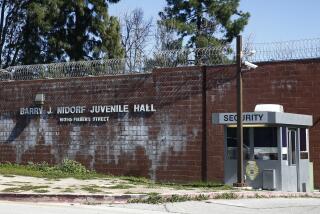Anti-Terror Readiness Still Lacking
Government agencies in Los Angeles County have spent tens of millions of dollars over the last 18 months to protect the area from a possible terrorist attack, but officials say they have not been able to find money for key safety measures.
Los Angeles has spent more than $90 million to bolster security at Los Angeles International Airport, and the county has spent about $28 million to set up bioterrorism response units. The Los Angeles Department of Water and Power bought two helicopters for $4.4 million, upgraded water testing and hired more security officers to patrol reservoirs stretching from the Owens Valley to Silver Lake.
Meanwhile, as the new federal Department of Homeland Security urges Americans to prepare for possible terrorist attacks, the ports of Long Beach and Los Angeles report that they are waiting for federal funds to help them identify and inspect suspicious cargo containers.
A countywide early warning group, set up as a federal pilot project to coordinate information sharing among more than 80 cities, is operating on a shoestring budget. And many cities in the area continue to use communication systems that are incompatible with one another, making it impossible for them to communicate with one another in case of an attack.
“We’ve dug deep into our own pockets,” said Los Angeles Mayor James K. Hahn. “Now we really need the help of the federal government.... Getting their attention is very difficult. Everything is East Coast.”
Shortly after 9/11, the federal government sent some money to local agencies across the country with the promise that $3.5 billion in emergency aid would follow. But that money has been tied up in Washington, and Homeland Security Secretary Tom Ridge recently told Hahn to be patient. President Bush signed the bill that authorizes the spending just last week.
Hahn said about $10 million has been spent so far at the Port of Los Angeles for additional security officers, and about $94 million has gone into a variety of measures at LAX, including perimeter fencing that includes motion sensors, lighting and cameras. The Fire Department has staffed an additional hazardous materials unit at the harbor and bought three new fireboats. It has also provided additional radiological and biological treatment equipment to field personnel.
But other city lawmakers are critical of Los Angeles’ efforts to date. “Frankly, things have been moving pretty slow around here,” Councilman Jack Weiss said. “L.A. seemed to believe that it couldn’t happen here. The sorry political reality is that politicians can see no upside in spending their limited resources and time on anti-terrorism.”
John Miller, recently hired by Police Chief William J. Bratton to head up the LAPD’s new homeland security division, said he was surprised when he arrived in town a month and a half ago that the city wasn’t further along in preparing for an attack.
“There was an awful lot that hadn’t been done here and wasn’t being done here,” Miller said. “In some regards I was surprised, because I had seen the extraordinary effort that New York City had done in the year and a half after 9/11.”
Over the last month, Bratton and Miller have moved to set up anti-terrorism units. A tip line was created earlier this month for residents to use in reporting evidence of terrorist activity in the city. (Of 500 calls the first week, 100 were leads that needed follow-up. A dozen have turned into significant investigations.)
Miller hopes to expand the number of officers working on anti-terrorism efforts to 250 from 100. Because the department has not received any additional funds for its security efforts, those officers will be reassigned from other duties.
The LAPD recently conducted a live-action exercise at LAX, allowing hundreds of so-called “first responders” from a variety of area law enforcement, fire and health agencies to respond to a simulated terrorist attack. The exercise, called Operation Nighthawk, revealed a number of deficiencies in the city’s preparations, Weiss said. Among those, he said, was poor coordination among emergency medical and security personnel.
Officials have also focused on the ports.
Together, the Los Angeles and Long Beach harbors account for 35% of the international trade moving in and out of the United States. Port officials estimate that they need $10 million to build a container inspection facility where suspicious packages and freight containers can be opened and inspected. So far, the federal government has appropriated $1.5 million.
Local efforts at the port have been augmented by the Coast Guard, which launched a new security team made up of about 100 employees and reservists after 9/11, and the U.S. Customs Service, which has increased the number of cargo inspectors by 70 since the terrorist attacks.
At the county level, the Board of Supervisors approved $6.8 million to boost preparedness in the immediate aftermath of the attack on the World Trade Center and Pentagon. Among other things, the money funded decontamination units at four county hospitals, disaster training for health workers, security guards and barricades at a few county buildings, intelligence gathering and computer protection against cyber-attacks.
The Sheriff’s Department was given almost $1.4 million to improve analysis at the county’s Terrorism Early Warning Group, to bring together a team of about 25 full-time law enforcement and other anti-terrorism workers; to link local officials to national security intelligence; to buy more vehicles and computers; and to hire a few more workers for its mobile command post.
Since then, however, anti-terrorism spending has sometimes languished as the county has slogged through the cumbersome process of propelling federal dollars into cities and facilities that need them.
“We haven’t received any grant moneys for a few years,” said Battalion Chief Mario De Fina, head of the county Fire Department’s terrorism section. “Because the money is coming from a federal source, like with all bureaucracy and red tape, it takes forever.”
Washington has approved about $6 million for the county, but none of it has been disbursed to local cities.
One chunk, about $2.1 million, is earmarked for 32 cities and a few county agencies to buy breathing apparatus, safety suits and gear capable of detecting radiation.
Bob Garrott, assistant manager of the county’s Office of Emergency Management, said the demand far outstripped the available resources: 44 cities applied for the grants, asking for a total of $6 million.
Los Angeles County is awaiting an additional $2 million to $3 million in federal funds for more equipment, including emergency vehicles and laptop computers. But it will be at least four months before that cash, which trickles from federal to state to county and finally to city officials, comes through.
Even so, Garrott maintained, Los Angeles is probably better prepared for a terrorist strike than the rest of the country.
“Because we are the disaster capital of the nation -- with our earthquakes, fires, floods and riots -- we have a lot of first-responders and emergency managers who have experience dealing with major events.”
So far, more than $28 million in federal funds has gone to the health department, which would play a lead role in the event of a bioterrorism attack or a large-scale disaster that injured thousands of people.
The county’s public health system has been preparing for bioterrorism for about five years, prompted by a series of phony anthrax scares. But the network is under substantial strain. Its overcrowded hospitals, which care for millions of uninsured patients, have been chronically starved for money.
Last year, the county received a $24.6-million grant from the U.S. Centers for Disease Control and Prevention for bioterrorism preparedness. It also got $3.6 million from the Health Resources and Services Administration to develop hospital response plans
The CDC money has been earmarked for several major upgrades, including replacement of the county’s public health laboratory, the first line of defense against any bioterrorism agent. But it will be months before ground is broken on a new site in Downey.
For now, said Dr. Jonathan Fielding, the county’s public health director, scientists are forced to make due with a 1960s-era lab.
“It’s woefully inadequate and inefficient,” he said. “We can’t even get pieces of equipment that we need up to it, because the elevator won’t accommodate them.”
The health resources administration funds, meanwhile, will pay for safety suits and, in some cases, outdoor decontamination showers at local hospitals. Some money will go toward improving surveillance for possible disease outbreaks, increasing pharmaceutical caches and building a disaster-response staging facility.
But the hospitals won’t have the new equipment until March at the earliest, said Carol Gunter, acting director of the county’s Emergency Medical Services Agency.
Even as they try to steer around major gaps in equipment, communications and training, county officials insist that Los Angeles is better primed to handle a terrorist attack than it was a year ago.
“Everyone always wants to know, ‘Are you prepared?’ There’s no such thing,” Fielding said. “Preparedness is a journey, not a destination. You always want to increase your preparedness.”
*
Times staff writer Deborah Schoch contributed to this report.
More to Read
Sign up for Essential California
The most important California stories and recommendations in your inbox every morning.
You may occasionally receive promotional content from the Los Angeles Times.










